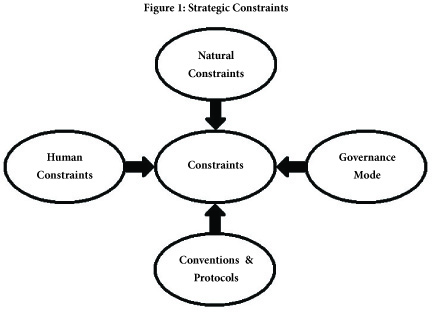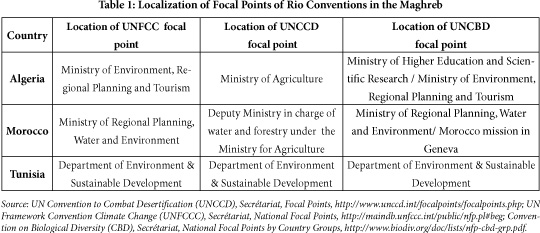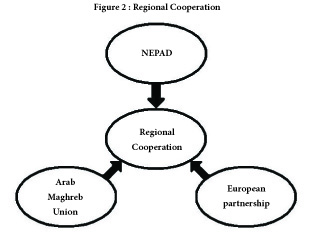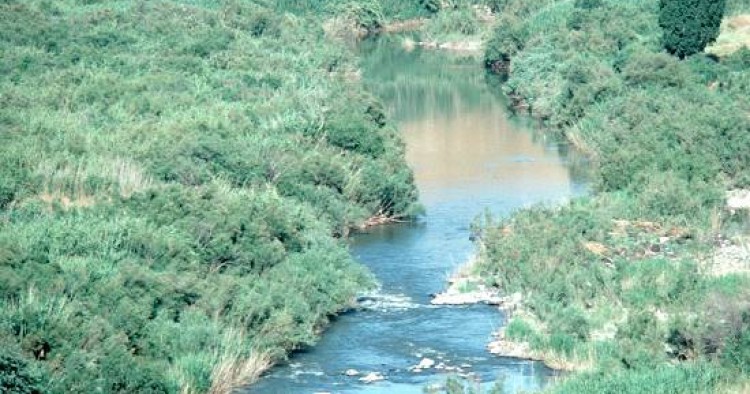The Maghreb extends about 2,000 kilometers on either side of the Greenwich meridian (-13° West from Cabo Jubi and 11.08° East to Kelibia) and is located on the same longitude as Europe. Although the Maghreb forms a single climatologic and geographical unit, it is a diverse landscape of mountains, fertile areas, and steppes. Nevertheless, the similarity of climate, geography, and culture in the Maghreb provides a solid foundation for developing a common environmental strategy.
Elaboration of a Sustainable Development Strategy
A common environmental strategy for the Maghreb must address four types of constraints: natural, human, mode of governance, and management of obligations related to conventions, protocols, and principles worldwide.
Natural Constraints
North Africans are unanimous with respect to the natural constraints they face: scarce and precarious water resources (quantitative and qualitative decreases in drinking water), erosion and silting of dams, increased desertification, forest fires (20,000 ha of forests disappear every year both in Algeria and Morocco), loss of biodiversity, limited agricultural land compared to that of the northern Mediterranean, reduced soil quality and water salinity, heat waves, and floods.
Constraints Due to Man
These constraints are often the result of the actions of marginalized sectors of the population: fragile land clearing (as in highlands and steppes), declining aquifer levels by water overuse (land subsidence and intrusion of marine waters in coastal aquifers), air pollution, climate change, water and soil, uncontrolled waste and management of watersheds, flood risk, poor control of seismic standards for construction with periodic, and great losses of human lives and infrastructure.
Constraints Due to Governance Mode
Sustainable development cuts across all sectors and requires the involvement of all institutional actors in a coordinated fashion. In the Maghreb, vertical governance inherited from the colonial period persists today. The great difficulty is the lack of a culture of coordination within each country. The establishment of commissions or coordinating committees in the environmental field often serves as an alibi for postponing decisions or getting rid of sticky issues.
 Constraints Related to Implementation of Environmental Conventions
Constraints Related to Implementation of Environmental Conventions
Like other regions of the world, the Maghreb is implementing obligations related to many conventions, protocols, and principles to which it is committed.[1] Within the Maghreb, implementation of such obligations is entrusted to a specific institution or department that houses the national focal points of the Rio conventions. Generally, these focal points are located in different institutional structures. An inventory of fixtures was realized in October 2006 by the secretariats of three conventions on the location of the various focal points of the various conventions in three countries of the Maghreb (Algeria, Morocco, and Tunisia) (See Table 1).
Competitiveness at the national level between ministries and governmental institutions sheltering the national focal points of various international conventions results in much of the duplication of requests for technical support and funds for projects which can be integrated or have similar objectives. These projects are implemented in an inadequate manner and sectorized at both national and international levels. This has resulted in 1) a deficiency in coordination and integrated vision within various international conventions and 2) the dispersion of national focal points between several institutions.

The obligations regarding the conventions relate to elaboration of inventories and action plans which are interdependent and sometimes even overlapping, involving a waste of human and material resources. To deal with complicated, delicate, and imbricated questions arising from multilateral agreements on environment, the UN Environment Programme (UNEP) in its report (UNEP/IGM/2/3 of June 28, 2001), summarized the various opinions expressed by experts on the implementation of the environmental conventions:
[ … ] the national governments had to ensure a satisfactory coordination at the governance in relation with the environment is related to the lack of coordination at the national level as well as the absence of fundamental elements constituting a functional legal framework. It was pointed out the UNEP that could provide opinions to the governments so that they could ensure this coordination at the national level, while indicating that its efforts would be reduced to nothingness in the absence of the necessary political will to attack the problems. It was advisable to support the complementarity of conventions on environment as well as a flexible coordination of the conventions secretariats and to encourage the supply of an effective assistance to countries helping them to implement their obligations towards the multilateral instruments on environment to which they are committed. It was important to direct the activities of these secretariats which were disseminated in various points of the world. The coordination, between multilateral agreements on environment and United Nations organizations, was somewhat lacking [ … ] at least by the fact of their number? The agreements represent an enormous administrative burden for all governments, in particular those of developing countries. This is why it would be advisable to seek more effectively to manage the multilateral agreements on environment within the vaster framework of international governance regarding the environment [ … ]. Some urged to examine the question of possible development of universal mechanisms for applying purposes and respect of multilateral agreements about the environment of which the UNEP would ensure coordination. Others stressed that such a formula should plan to build capacities of developing countries so that they will be able to apply the agreements to which they are committed.
Regional Cooperation
Here, we limit ourselves to cooperation on environmental matters. The regional level includes: the Arab Maghreb Union (AMU), the environmental initiative between the New Partnership for Africa’s Development (NEPAD) and the United Nations Environment Programme (UNEP), and the agreements between the Maghreb and the European Union.

Arab Maghreb Union (AMU)
The AMU, which was created in 1989, consists of five countries: Algeria, Tunisia, Morocco, Mauritania, and Libya. In the environmental field, some technical projects and studies have been implemented, such as URAP (under the regional action plan to fight desertification), studies on underground water sheets of the Sahara, and the elaboration of a Maghreb charter on environmental protection and sustainable development. However, cooperation with the AMU framework has slowed because of the Western Sahara conflict. Nevertheless, some regional joint projects have been realized under the auspices of international organizations, as have many scientific exchanges.
Environmental initiative between UNEP and NEPAD
This initiative, elaborated jointly by the African Ministerial Conference on the Environment (AMCE) of NEPAD and UNEP and adopted in 2003 by the African Union (AU), aims at improving the environmental conditions to spur economic growth, eliminate poverty, build capacities for the improved application of international environmental conventions, and take up the challenges within the global framework of implementing the NEPAD. The designated areas of action within this initiative are the fight against desertification, droughts, soil degradation, integrated management of water resources, prevention, control and management of invading species, climate change, management of marine and coastal environment, and conservation and management of natural resources (forests, biodiversity, bio-security, genetic resources). It includes the cross-section questions like early warning of catastrophes, health and environment protection, poverty reduction, and technology transfer. The projects identified for the Maghreb are:
- management of watersheds (Mellègue Wadi in Tunisia and Algeria and M’soun Inaoune in Morocco);
- rehabilitation of oasis ecosystems;
- creation of an observatory for natural droughts, desertification, and natural disasters;
- reinforcement of green barrier, conservation, and sustainable use of natural resources in Maghreb countries;
- the long-term implementation of a network of ecological control
- use of geographical information systems in the field of water resources.
Maghreb and European Union
Without a doubt, cooperation between the northern and southern littoral states of the Mediterranean is a necessity. It goes beyond the purely economic considerations by taking into account other requirements such as environment, climate change, human mobility, and security.
1) Euro-Mediterranean Partnership (EMP):
Within the framework of the Barcelona Process, the association agreements between EU and Maghreb countries were worked out to implement the MEDA (Mediterranean Assistance) objectives laid down by this process. Tunisia was a pioneer with the signature of the agreement in 1998, while the association agreement for Morocco goes back to 2000 and that for Algeria to 2005. The table below indicates the allocated funds to each country, within the framework of the MEDA program.

This table provides some information on the degree of commitment and efficiency with regard to the use of MEDA funds allocated to Algeria, Morocco, and Tunisia. Tunisia consumed credits amounting to 64.9%, followed by Morocco with 53.2%, and 32.9% with Algeria. This reflects, in a sense, the degree of commitment, organization, and efficiency of each country regarding the MEDA program.
MEDA support to Morocco
In Morocco the EU financed six projects intended to fight soil degradation within the MEDA program framework between 2001–2005. These projects were devoted mainly to sustainable management of land use, reduction of erosion, and soil conservation.
MEDA support to Algeria
The EU financed the sanitary and phytosanitary monitoring and early warning systems according to EU standards; the quality chain and improved standards for agricultural products, the conceptual support to agricultural diversification and for the studies of sectors; the promotion of Algerian-European partnerships in the agricultural sector; support for the preparation of negotiations under the Association Agreement and WTO; and the completion of a sector-based study on the effects of the national development agriculture and future development options.
MEDA support to Tunisia
This support has concerned all key sectors of economy and society modernization: macroeconomics, sector-based reforms (customs, ports, privatization, etc.), educational sector, financial reform, health insurance, media, and, soon, justice. The program concerning the ports is exemplary because it allowed, among other things, the complete restructuring of the longshoreman’s profession in acceptable social conditions.
2) Eurtopean Policy of Vicinity (EPV)
The EPV, launched in 2004, has replaced the MEDA program. The EPV aims to complement and reinforce the Barcelona Process through bilateral action plans agreed with all country partners inside and outside the Euromed zone. The EPV blurred the Barcelona Process and has tended to be imperative as the operating mode of cooperation. The EPV functions on the basis of action plans: Morocco and Tunisia signed their plans in 2004.
The EU Council considers the deep integration of the economy to be an essential pillar, which can be strengthened by the gradual adoption of free trade agreements that are understandable and robust and that help the countries of the South to adhere to with international standards of product labelling and the organization of foreign trade.
3) Union for the Mediterranean (UpM)
On May 6, 2007, France put forward the idea to create the Union for the Mediterranean (UpM). After difficult negotiations with other EU Member States, it was decided to call this initiative the “Barcelona Process — Union for the Mediterranean.” The EU thus wanted to reaffirm the predominance of the Barcelona Process on the UpM recommended by France. UpM was launched in Paris on July 13, 2008. It is an intergovernmental organization with a regional vocation that includes 44 members (27 of EU and 17 partners, including the Maghreb countries). It consists in activating the Barcelona Process by giving it more balanced governance by including EU partners. The priority actions concern the cleanup of pollution in the Mediterranean Sea and the development of sea lanes as well as solar energy.
Conclusion
There is a need for the development of a common environmental strategy for the Maghreb. This essay has discussed the growing number and diverse forms of regional and international cooperation on the environment that have taken place in the Maghreb in recent decades. However, it is also important to consider the effectiveness and impact on the ground of the projects that such cooperation has spawned.
We believe that these projects have served more to address the pressing concerns of individual states than to spur endogenous development that must be undertaken by national or local institutions or structures. We note the absence of a comprehensive and integrated vision for the medium- and long-terms that encompasses the Maghreb as a whole. This deficiency, coupled with poor governance at the state level, has impeded efforts to cope with the environmental challenges facing the region.
To be sure, some informal scientific exchanges between universities have occurred. To date, however, the only projects with a regional dimension were those initiated by NEPAD and some multilateral organizations (Global Environment Facility). The work done within the AMU framework was of a theoretical nature; it did not consist of projects on the ground.
In our view, regional or international assistance must be part of an overarching strategy with clear, realistic, and timely objectives. As part of that strategy, international assistance should be geared toward assisting the Maghreb countries to develop regional, rather than national, projects.
[1]. These include the Rio Conventions on Climate Change, Biodiversity, and Desertification; the Ramsar Convention on Wetlands; the Stockholm Convention on Pesticides; the Basel Convention on Border Transfer of Hazardous Waste; the Cartagena Protocol on Biosafety; the Kyoto Protocol on Greenhouse Gas Emissions; and the Montreal Protocol on Substances that Deplete the Ozone.
The Middle East Institute (MEI) is an independent, non-partisan, non-for-profit, educational organization. It does not engage in advocacy and its scholars’ opinions are their own. MEI welcomes financial donations, but retains sole editorial control over its work and its publications reflect only the authors’ views. For a listing of MEI donors, please click here.













